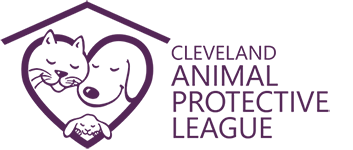![APL_logo_black [Converted]](https://clevelandapl.orgwp-content/uploads/2013/09/APL_logo_black-Converted-300x131.png) Chewing is 100% normal behavior for puppies and dogs. It is one way that they learn and explore their environment. For puppies, chewing relieves the pain of teething. For older dogs, chewing keeps the jaws strong and the teeth clean. Destructive chewing can arise out of boredom, anxiety, or frustration.
Chewing is 100% normal behavior for puppies and dogs. It is one way that they learn and explore their environment. For puppies, chewing relieves the pain of teething. For older dogs, chewing keeps the jaws strong and the teeth clean. Destructive chewing can arise out of boredom, anxiety, or frustration.
Normal Chewing Behavior
Dogs chew for fun, for stimulation, and to relieve anxiety. The best way to prevent destructive chewing is to provide plenty of appropriate chew toys for your dog. You must teach your dog that these are the items he is allowed to chew and deter him from chewing inappropriate items such as furniture, socks, or shoes. It is a good idea to rotate your dog’s chew toys so that he doesn’t get bored by the same toys day after day. This will encourage him to continue to chew the designated items.
Just like human babies, puppies lose their teeth and experience pain as their adult teeth come in. The most intense period of teething usually takes place around four or five months of age. To help relieve your puppy’s pain, you can give him ice cubes or frozen wet washcloths to chew. Gently guide him to appropriate chew objects and toys, and praise him when he chews these items.
Separation Anxiety
Some dogs chew most intensely when left alone because they are suffering from separation anxiety. Typically, these dogs show other signs of separation anxiety such as whining, barking, pacing, urinating or defecating when left alone. Dogs with this disorder tend to chew near exit points such as door frames or windows in an attempt to escape. If you think your dog is experiencing severe anxiety about being left alone, enlist the help of a veterinary behaviorist. She can develop a specially-tailored plan for you and your dog to combat the anxiety.
Preventing Your Dog from Chewing
To prevent your dog from chewing inappropriately, dog proof your home. Make sure that dirty clothes are placed in the hamper, keep your shoes in the closet, and place other items on high surfaces or shelves that your dog cannot reach. Prevention and management are often the best ways to ensure that your dog does not chew inappropriately.
Provide your dog with plenty of toys and chew items. Good choices include Nylabones, Greenies, natural bones, bully sticks, rawhide, Dentastix, and pig ears. Be sure to supervise your dog when he is chewing an edible item so that he does not choke. Only give your dog bones that are specifically for chewing as other bones can splinter and harm your dog.
You can use chewing deterrents such as Bitter Apple or Bitter Cherry spray to prevent your dog from chewing furniture or shoes. Spray the deterrent on these items every day for two to four weeks. Just using the spray, however, does not teach your dog what he is allowed to chew. So you must also redirect him to his toys and chew items when he starts to chew inappropriately.
Supervise your dog carefully, or confine him when you can’t watch him, until you are 100% sure he will not chew inappropriate items. Make sure that he gets plenty of physical exercise and mental stimulation so that he will not chew out of boredom or frustration. Allow him time to socialize with people and other dogs, take him for walks, and feed him out of food-dispensing toys such as the Kong or Tricky Treat Ball.
What NOT To Do
- Do NOT show your dog a damaged item and punish him for it. He will not connect what he did hours or even minutes ago with the punishment. This kind of treatment will simply cause your relationship with your dog to deteriorate.
- Do NOT crate your dog for more than 6-8 hours to prevent him from chewing. You must devote a significant amount of time to supervising your dog outside of the crate.
- Do NOT muzzle your dog to prevent him from chewing.


